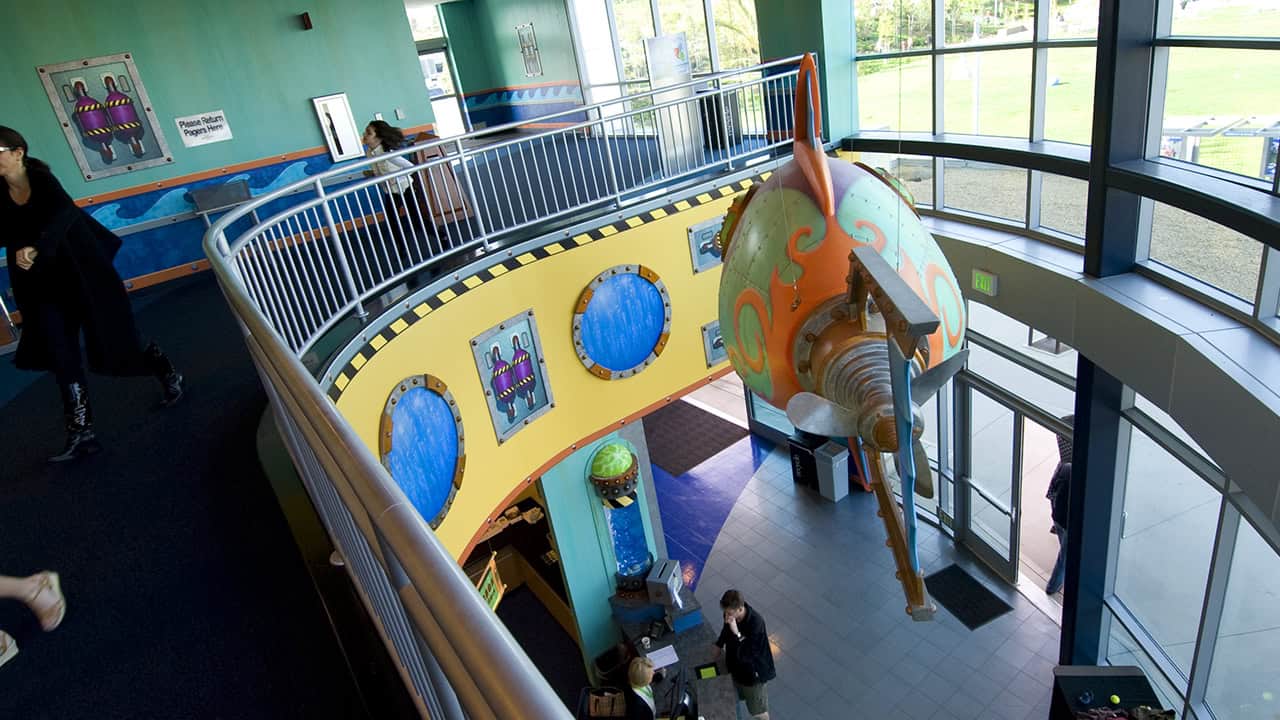What It Really Takes to Reach Young Families (Part 3)
If you enjoy this episode, subscribe on your device for more:
iTunes RSS Stitcher Spotify
One thing is often overlooked when it comes to engaging kids and families—the environment.
Creating compelling ministry spaces is crucial for reaching the next generation.
Justyn Smith from PlainJoe Studios has 22 years of experience in kids’ ministry. He works with some of the most innovative and creative churches in the country to develop compelling ministry spaces for children. We invited Justyn to share what he’s learned about reaching the next generation through dynamic environments.
KIDS MINISTRY SPACES
In this episode, Justyn and Tony talked about the best practices and common mistakes in creating an environment that engages kids and families.
- Best practices
- Common mistakes
- What success really looks like
Photo credit: Mariners Church via Plain Joe Studios
The best senior pastors have an obvious value for the next generation. [episode 366] #unstuckchurch Share on X Don’t underestimate the power of storytelling. [episode 366] #unstuckchurch Share on X What’s successful for one church may not be successful for another church. [episode 366] #unstuckchurch Share on X Vibrant faith in adults today is connected to how engaged they were in the Bible as kids. [episode 366] #unstuckchurch Share on X
This episode is brought to you by Horizons Stewardship:
Horizons Stewardship utilizes a collaborative and integrated ministry framework designed to fit each organization’s unique culture and support church and faith-based nonprofit leaders in their mission to grow disciples and fund ministry through coaching, planning, technology, and analytics.
Horizons has over three decades of experience and has developed a spiritually focused approach that consistently yields more funding for ministry and more effective disciple-making strategies. With the support of seasoned ministry strategists, proven generosity guides, and ICF-trained coaches, ministries that partner with Horizons experience, on average, a double-digit increase in giving within the first year.
Interested in learning more? Click here.
Leader Conversation Guide
Want to take this conversation back to a staff or senior leadership team meeting?
Our Show Notes subscribers get a PDF download that recaps the episode content and includes a discussion guide you can print out and use at an upcoming meeting.
Opt-in here and get access to the full Leader Conversation Guide archive.
More Episodes in This Series
- The Foundation – Episode 364
- Vision & Leadership for a Multigenerational Church – Episode 365
- Raising a Generation with Courageous Faith feat. Christie Penner Worden – Episode 367
Share Your Thoughts and Questions on Social Media
We use #unstuckchurch on X (formerly Twitter), and we start a real-time conversation each Wednesday morning when the episode drops. You can follow me @tonymorganlive and The Unstuck Group @unstuckgroup. If Facebook is where you spend your time, I’m there, too.
Write a Review—It Helps!
Your ratings and reviews really do help more pastors discover the podcast content I’m creating here. Would you take a minute to share your thoughts? Just open the the podcast on iTunes on your phone or computer, click Ratings & Reviews, and leave your opinion. Or leave us 5 stars on Spotify.
Transcript
Sean:
This is The Unstuck Church Podcast, and I’m Sean, your host today. This week we’re continuing our final series of podcasts from our founder and dear friend Tony Morgan, on what it really takes to reach young families. If you’re brand new to the podcast, you can go back and listen to our celebrating Tony Morgan episode to hear more about Tony’s sudden passing. Before Tony passed away, we recorded the remaining episodes in this series and decided to move forward with releasing them because this topic in particular was really close to Tony’s heart. So in this episode, you’re gonna hear Tony’s voice and his passion for healthy churches, and we believe his thoughts and his voice will help your church grow healthier, too. So here’s episode three of our series, What It Really Takes To Reach Young Family Series with Tony Morgan and Amy Anderson.
Amy:
Well, Tony, I’m excited to share this interview today. You know, one of the reasons why we wanted to include a discussion with Justyn Smith is because he has 22 years of experience in kids’ ministry, and now in his work with PlainJoe Studios, he works with some of the most innovative and creative churches in the country to develop compelling kids’ ministry spaces.
Tony:
Yeah. And by the way, I have churches ask me all the time, we’re trying to create great environments for kids and actually for adults as well. You know, who should we be talking to? This is just side conversation, but PlainJoe, they have a great team. So this is exactly what they do do is help ministries help churches reach the next generation by creating compelling ministry environments. So you should reach out to PlainJoe, but specifically, related to Justyn, he just has unique experience. He’s incredibly creative, and he’s been part of developing some pretty incredible kid spaces. And we spent some time talking about creating an environment that engages kids and families hitting on some best practices, some mistakes that many churches make, that they regret later on, and what success really looks like. So here’s my conversation with Justyn Smith. I hope you get inspired.
If a church is engaging young families, it’s pretty easy to see. And what’s less obvious, though, to the outside observer is all the decisions that have been made to become a church those parents and kids want to attend. So in this series, we’re unpacking what it really takes for a church to reach and engage young families. But before we dive in, Justyn, could you share a little bit about your background with Kids’ Ministry and at PlainJoe Studios?
Justyn:
Yeah, absolutely. I’ve been in kids’ ministry, or next Gen ministry for the past 22 years, and I’ve been with PlainJoe for the past 18 months. And what I do with PlainJoe Studios is as a story catalyst is I help churches tell their stories better. So I really try to make that relational connection with churches. There’s people out there who are searching for better ways to communicate to young people, to create engaging environments for them. And so that’s where I come into play. So I take my 22 years of experience with kids ministry, really leading anything from startup churches to churches of 10,000 people taking that experience and helping PlainJoe help churches tell their stories in a dynamic way. So, yeah.
Tony:
Needless to say, Justyn, I get into a lot of church buildings, and it’s pretty easy to see when churches have decided to empower teams like PlainJoe to design facilities and spaces, and when the building committee’s in charge of those decisions. But along those lines, I know PlainJoe works with some of the most innovative and creative churches in the country. Give us a peek behind the curtain. What’s different about the way the leadership in those churches operate?
Justyn:
Yeah, so obviously there’s a ton of amazing leaders out there—all have great qualities. I’ve worked with some of the, I think some of the best senior pastors in America today. But yeah, working with those churches, pastors that you would know, that the audience listening would know as well, is I think that a few things that stick out would be, they have an obvious value for the next generation. And I always like to put the word obvious there, because some people will say they value the next generation. It’s on their mission wall. It’s on their plaques that they have in their hallways. But it’s not so obvious beyond that. And so, these are leaders who, they invest heavily into the next generation. They’re talking about the next generation, the quality of staff that they have reflects their value for the next generation. So it’s very obvious.
And then oftentimes it’s even the space. So you walk into some of these churches, and it doesn’t have to be a huge mega church, but you walk into a church and it’s just obvious that they love young people. And so those leaders tend to really fan those flames a lot. They’re visionaries, but they don’t just cast vision. They’re very down to earth as well. So, and this is these are these, you ask the question like the people behind the curtain of some of the best leaders. So it’s not the ones who are just cast vision, because you can cast vision all day long, but if you don’t have the means or it’s not the right strategy, then it’s not gonna come to pass.
But these types of leaders, they seem to not just have vision, but they’re really down to earth, know how to make it come to pass or have surrounded themselves with people that can make that vision happen. They’re unafraid. So these are leaders who, they’re not afraid to make challenging decisions. They’re not afraid to make the hard call where others might. And so, you know, especially like when I think of the field with PlainJoe Studios, when you’re dealing with paint, with carpet colors, with all the environments, you’re stepping on some toes, for some people who’ve been there a long time. But these are pastors who are like, look, we believe in the next generation, we wanna reach families, people who are far from God, and this is what we gotta do. So they’re unafraid to make some of those more challenging decisions. And they have an incredible high level, high capacity teams that they surround themselves with. And so, I’m always inspired, always amazed when I get into a room with their teams. ’cause it’s executive teams and kids teams, youth teams, whatever. And they’re just some of the sharpest of the sharpest people out there. So they get it.
Tony:
That’s great. Alright, so you and your team have been creating some incredible kid spaces. So I’m hoping we can spend some time talking about creating an environment that really does engage kids and families. What are some of the best practices that church leaders need to consider for creating an excellent environment, especially for kids?
Justyn:
Yeah, I could spend all day, obviously we don’t have all day to talk about this, but so let me just bullet point several items real quick. One is understanding your audience. Who are you designing for? Who are you creating the environment for? You know, for example, worked at a church, was part of a large church, and our audience was actually more parents and volunteers. And so the thinking was, the kind of the Starbucks model a little bit was, you know, Starbucks has that thing where if their baristas are happy and have a good experience working, they think that their customers will have a good experience buying coffee and being a part of their environment. Well, we thought something of the same thing was, if volunteers enjoy being in the space, ’cause sometimes when you theme spaces, it can be super, super bubbly, cartoony, and it’s, it can be somewhat annoying to be quite honest. And you’re asking adults to spend a lot of time in that space as well. So if you can design a space that not only captivates kids, but also a space that volunteers enjoy being in as well, that makes a big difference.
So it’s understanding your audience. Who do you want your audience to be? Who are you designing your space for it, is a big deal. And not just understand the audience in that case, but just understanding, just your, I mean, if you’re an urban church, it’s different than a rural church, different than, I mean, there’s so many different factors that you, that come into play, but just understand who you’re trying to create for is a big deal.
And use storytelling and theming. You know, there’s a thing out there, I think the past few years where churches are starting to go a little more generic. And I understand all the reasons behind that. I mean, there’s very practical reasons behind that. But what they’re missing is the storytelling and the themeing aspect of it, which is the wow factor. It’s the part that, you know, new families, ’cause that’s what you’re trying to engage. I hope you’re trying to engage new families or people who are far from God. You want you wanna leave them with the just that like, wow, I can’t believe this is church. I wish I had this when I was growing up, type of feeling. And so don’t underestimate the power of storytelling. Storytelling is a big deal.
Safety’s gotta be like your number one priority. And so when you’re designing a space, an environment for kids, I mean, you’ve gotta be thinking of access points and you know, what kids can reach and can’t reach and touch and not touch and all those types of things. You know, sometimes we overlook that, you know, the sharp corners on the walls or on the count. I mean, just those little simple things make a big deal. And can’t be underestimated.
Interactive objects: I mean, don’t be afraid to, when you’re designing spaces to have things that kids can touch. You know, those hallways don’t have to be just planned hallways. They can be hallways that have just interactivity going on where they can touch things on the wall, or you can project things on the floors or on the ceilings or you know, bring your phones. And they can search things like they do with Pokemon. I mean, you can be super creative, to draw people in in that way.
I’d say functionality and flexibility of space is a big deal. And so, what are you using your space for? There’s some churches that simply as as much as they wanna use a dedicated children space, they just simply don’t have don’t have the room, because the type of ministry that they do, they just are doing a lot all the time, and they need the space. And so be thinking about that before you design your spaces, because you can still create a dynamic themed amazing space for children, or for students, even though you’re need a flexible shared space.
But so think of that as well, just I mean, creating things like creating a welcoming atmosphere. So what is that, what is that first welcome when you’re creating a space, what is that first thing that people see when they walk into a classroom? You know, the colors, are they warm? Are they inviting? Or does it feel more like a storage facility, kind of you know, get here, get in and get out, engaging beyond physical spaces. And so, you know, we talk about the physical space, but environments aren’t just physical, but it’s environments are the words that you say you’re creating the environment. You know, when you go to Disneyland, you’re not a customer, you’re a guest, right? They don’t have employees, they have cast members. And all those things make a big difference. And they help create the environment that you’re in, the tangibles that kids leave with, I mean, make a big deal. And so you can tie all those things together, when you’re creating a physical space, to make a lasting impact. It’s so cool, I think, when you create a great space, but they can take some of of that home with them somehow and reflect back on that during the week and be like, Hey, I wanna remember that church. That was really cool. Let’s go check it out.
Tony:
Yeah. That’s so good. As you were going through that list of best practices, I’ve gone into churches and sometimes they make the decision we’re going to have our adults meet in kids spaces because we don’t have enough room to have dedicated spaces for both. And then sometimes churches make the opposite decision. They say, we’re gonna let kids use adult spaces. If you have, if you don’t have enough room to have dedicated spaces for both, please invite your adults to step into kids spaces. And I mean, the primary reason why is you’re casting vision to your entire church, whether those adults have kids or not, that we are a multi-generational church trying to reach the next generation. And as adults, we should be prioritizing and sacrificing so that we can engage that next generation. So, yes, don’t stick your kids in beige classrooms. I mean, please don’t do that.
Justyn:
I tell people that all the time. You never go wrong. Inviting adults into a kid’s classroom. But it can have the opposite impact by doing what you just said by doing the opposite, so, absolutely.
Tony:
Yeah. That’s right. All right. So I’ve started to move us in this direction, what are some of the mistakes, Justyn, that you see churches making with kids spaces, that in hindsight, they probably wish they would’ve done something differently?
Justyn:
Yeah. I love this question because I think one is, in hindsight, for whatever reason, it seems that children’s ministry spaces seem to get cut. So in other words, like if you’re building a new building, if you’re expanding, if you’re investing more into physical space, it does seem like kid space kind of gets, we will turn that to phase two. Or we’ll turn that to phase three, or we have to cut the square footage. Let’s try to make this classroom smaller or yeah, we’re not gonna go all out in themeing. We’re gonna cut way, way, way back. And I think that churches look back, because it’s, I know there are people much smarter than I am, looking at numbers and they see it coming through. So I know there’s probably, in their heads, good reasons why to to do that. So it’s hard for me to criticize some of those decisions.
However, I do know in a few years from now, when those decisions are made, they usually look back and think, man, I wish we would have made, you know, spent the extra money to do that. I wish we would’ve not cut back on the square footage. I wish we would’ve gone all out in theming, because it’s rare for churches to kind of come back and do it. It does happen. But I’m just saying it is rare. There’s always the intention. But it just, life happens, church happens, other stuff happens. And you find that you’re reallocating those dollars in other areas. And so I find that in my conversations, they are like, man, I wish we would’ve done that.
I’d say one of the biggest things though is, they don’t spend enough time on their why, before they start creating a space, renovating a space, theming a space for kids. They don’t spend enough time on their why. So oftentimes you get a pastor, again, great intentions. They’re like, we just, we wanna create a fun space for kids, right? And it just, maybe they just don’t have the experience in children’s ministry or or whatnot. But the heart is there. The heart is like, let’s create a fun, engaging environment for kids. And so it’s almost like in their heads, they’re just thinking, you know, maybe like Chuck E. Cheese, let’s just do something, you know, a cool design on the wall, and put a cool game over here. Not realizing that when you do that, you’re gonna end up, you’re gonna find yourself, re theming over and over and over again, redoing the space ’cause you’re gonna get a new kids leader that comes in, and the new kids leader is gonna have a different kind of vision, different kind of heart, different kind of brand or whatnot, and wanna take it a different direction. And now you’re spending more money on that, or frustrating that leader. And the thought is, if you were to spend time on your why, you’re gonna create a space that’s not centered around any specific leader, but the space will be centered around your mission and your vision as a church. And so, whomever is leading that department, it doesn’t matter that the theme is what it is, because that theme is reflective of your church. And so when that leader comes in, hopefully you’re not hiring a leader that you know, it shouldn’t have to change all that, because they’re not changing the mission and vision of the church. They’re just they’re doing the kids’ version of that.
And so I think that when you can spend more time on your why and really think through that as a team, I think that you’ll create a space that will not become outdated quickly, that will be engaging for kids for a long time. Because that’s one thing people are afraid of. They’re afraid that if I theme, it’s only gonna last X amount of years, well, if you theme correctly, I think you can get a good decade out of your themeing if not longer. If you don’t spend time on your why and do it correctly, then you’re right, you’re gonna go through it a lot faster. But that’s one thing I love about Storyland, is that we just, our process of storytelling and walking people through that, we go through that why?
And then I’d say like, you know, maybe like going on the cheap, you know, you get what you pay for. So if you’re gonna spend very cheaply, it’s gonna look like that. And things may not last as long. And I think people, when I’ve had conversations with people, in the past, those are the few things that really kind of stick out.
Sean:
Hey, listeners, this podcast is free to you, but takes considerable resource to produce, and it wouldn’t happen without our weekly podcast sponsors. This week’s podcast sponsor is Horizons Stewardship. You need a generosity playbook to help you take the guesswork out of growing disciples and funding ministry. Horizons stewardship can teach you how to elevate your impact and achieve your mission with creativity, clarity and confidence. Horizons Stewardship is a team of generosity specialists, coaching professionals, and ministry strategists who’ve helped thousands of churches and faith-based nonprofits raise billions for impact for over 30 years. If you’re ready to unlock the power of generosity and elevate your impact, visit nextlevelgenerosity.com today to discover your generosity advantage.
Tony:
Alright, so coming out of the pandemic, I think a lot of pastors and church leaders were just curious to see how is this going to change how we do church? And I know there are a number of areas of ministry that look a little bit different in recent years compared to decades past. How are you seeing successful kids’ ministries changing over the last few years? What’s different about what works now and what’s the same?
Justyn:
Well, I mean, first I would say this first, I would say you have to really kind of, I mean, what’s successful for one church may not be successful for another church. And so I think you have to kind of define, you know, what is success. So I just put this out there. This is just my few bullet points of what a successful children’s ministry would look like is one I put, make a child feel like they belong, create memorable experiences and go all in on Bible engagement. So just over the 20 plus years that I’ve been doing it, I feel like if you do those three things well, I think you have a successful children’s ministry. And that’s not to say if I miss something, it’s not important. Those just the three that kind of rise the top for me.
And so I think a lot of pastors, like, again, like we value kids’ ministry, but it just doesn’t, it just doesn’t show, if I can just be blunt, it just doesn’t show up in sometimes the quality of leader, because sometimes the quality of leader is, and I’ve heard the stories countless times of, you see someone in the hall who is maybe a stay at home parent or has time, and you just pull them to come lead the kids. Well, by you doing that, it, you’re kind of sending the message that you don’t value kids. You say you do, but you just took someone who has no experience, but just has time, has availability, which is great. So God bless them, bless their heart for doing that. But the reality is, you probably wouldn’t do that for anyone teaching on the main stage. And some other ministries you would, you would expect, you’d have a higher expectation. And so I think that there’s been a kind of a, there’s been an upswing I’ve noticed in quality of leader, which has been great. And I think the pandemic kind of forced that a little bit because you got some people who just couldn’t cut it. And it’s not bad. It’s maybe just not gifted, didn’t have the leadership credentials or whatever. And so I think that was a good thing.
And I, kids belonging, I think, I think kids have always, or should have always felt like that they belong a pre pandemic, post pandemic. I think that especially now, maybe not even because of the pandemic, but maybe more because of technology, the feeling and the reality of kid wanting to belong and have that feeling is more crucial than ever. So I don’t really relate that to pandemic. I relate that more to technology and to this generation.
And creating memorable experiences. I think is a big deal. You know, for example, when a grow, when someone grows up and maybe they kind of drift, you know, they drift from their faith, or, I don’t know, different theologies or whatever, they fall from their faith or drift from having a fruitful, deep relationship with Jesus. Oftentimes they don’t remember necessarily all the lessons. But there’s a memory there. And so what I say, what I think is like, if you can create memorable experiences when they’re, I think when they’re at their lowest, I just picture someone in their twenties or thirties or whatever, and they’re going through a low time, a low time, they may not remember my name, but they’re gonna remember, man, I remember that Space Station Church I used to go to because it was memorable, right? I mean, Disneyland, Disney World, when you walk through there, it’s memorable. But if you go to ABC theme park, you know, down the road, it’s not memorable. You had a good time in the moment, but you don’t remember it. And so the memories kind of bring you back. And so I think sometimes when you can create those memories, for someone, it’s basically a seed you planted and it could cause them to wanna come back. I’ve heard those stories many time, they don’t remember the teacher’s name, but they remember the lesson, they remember the environment that they’re in.
And Bible engagement. I mean, right now statistics show us that those who have a vibrant faith in Jesus today, the adults, it really is connected back to how engaged they were in the Bible when they were a kid. And so, if you can engage kids today in the Bible in a significant way, I mean, memorizing scripture’s a part of that, but, you know, understanding scripture the best you can, you know, up to for fifth grader, it makes a big deal in their faith growing up.
And so I mean, what’s changed over the years? I think mainly it’s the quality of leader. I think what’s happened before is happening again. I had a leader the other day come up to me like, man, we’re doing this really cool thing. We’re doing Bible bucks, and if kids do this and this, we give them, we give them Bible bucks and they can turn it in at the end of the month to get something outta store. I’m like, that’s awesome. I’m so glad. I didn’t wanna tell ’em that they’ve been doing that since the eighties, and it kind of fell out of fashion, but it’s coming back again because they know that, if you’re rewarding the right behavior, that will actually make a big difference. But it kind of fell out, fell out for a long time, and now it’s kind of coming back. And so those little things are funny to me. And but I’m glad we’re doing them.
Tony:
Just so you know, Justyn, everything that happened in the eighties was so good, and it’s just a good thing when that decade revisits us, right? It’s a good thing. It wasn’t that long but years ago you wrote a book called If Disney Ran Your Children’s Ministry. And Justyn, I think a lot of people have kind of a love-hate relationship with Disney, but it’s impossible to deny, right? They know a lot about engaging kids and parents and compelling experiences. So would you share a few principles you highlighted in the book, that you think senior church leaders need to know right now?
Justyn:
And to your point, yeah, I have a love hate relationship with Disney because they definitely do not reflect all the values that I value. But there’s no denying. They have probably one of, if not the biggest impact on our culture today and on young people and on families. And so there are definitely things that I think we can learn from them. And I think especially from like Walt Disney’s past, like think of like, you know, classic Disney back in the thirties, fifties, et cetera. You can learn a lot, but yeah, I would say some of the things that come to mind from that book, and then a follow up on that, we did Kidman, Trust and Pixie Dust, same type of thing. Talking about Disney is, and we’ve already talked about, but invest in your kids’ ministry, invest in your kids’ ministry. While Disney and Universal Studios, universal Studios, just announced probably a year and a half ago or so, Disney, $60 billion that they’re investing in their themed entertainment, experiences. Universal Studios investing $17 billion in their theme parks over the next 10 years.
And so when people say, oh, theme, you know, we’re, we don’t want a theme because we’re afraid to get stuck in something, or it’s not today, and they kind of go this generic route. I’m like, you guys, the Disney company is investing $60 billion in themed memorable experiences. I said, there is something there that they’ve tapping into something. I’d say even post-pandemic, especially is people are, people want experiences. They want something memorable to do. And I think the church has an opportunity to tap into that. You can create environments, whether it’s creating a VBS that’s over the top, theming and making that cool or a something that’s there week in and week out in your kids’ ministry. It will, I guarantee it’ll make a difference. You’ll see a return coming. And so I just take the cues from these companies that are doing it the best.
And so there’s one, I kind of mentioned already, but in the book, you know, we say kids are important in our church, but sometimes we don’t grab the right leaders. You know, Walt Disney had great, surrounded himself with great leaders, with people who were great at certain specialized things. And so I would say, find people who are specialists and invite them on the team, you know, if you have opportunity to pay them on the team, do it. If you don’t, I guarantee you there’s people in your church who are gifted in ways that you’re not tapping in that could change the trajectory of your kids’ ministry. And so tap into some of them. I did that. I wasn’t very good when I first started doing kids’ ministry at organization. And there was someone who worked for Starbucks, oversaw like seven or eight Starbucks where I lived, and him and I got together. He didn’t even like kids ministry, but he loved organization, and I got him on the team, and he helped radically transform our volunteerism from literally having about mid twenties in volunteers to having over 600 volunteers. And it started with him helping out with some organizational foundational things. And I see that in Disney. Disney creates structure that makes a difference. And storytelling. Storytelling is powerful. It’s what changes culture. It’s been around for generations and generations. And so tell stories, not just from the stage, but tell stories for, with your environments.
Tony:
Justyn, that’s so, so good. Thanks for giving us a vision for what kids ministry can and I think should look like in the churches today. So thank you for that. Any final thoughts you wanna share?
Justyn:
My final thoughts would be, don’t be afraid to invest. You’re investing your time, you’re investing your money. You’re investing your best into your kids’ ministry. And so you’ll never go wrong with that return. And so you can invest in a lot of things in the church, but one place you’ll never go wrong is investing heavily in your kids’ ministry. And so to a pastor who’s out there thinking, man, should I, should I not? Or man, we are about to do this campaign and we’re focusing on this aspect of church. I guarantee if you start thinking about those young families, you start thinking about those kids out there, the community will take notice. The church, your parishioners in your church right now will take notice and it has the opportunity to change your culture in a very positive way or keep your church on the right trajectory that it’s already on.
Amy:
What a great conversation, Tony. When he was describing the leaders in churches that have thriving Kids ministries. I loved how he said it. He said, see, they have an obvious value for the next generation. That’s what I was saying last week when I said, I can walk into a church and I can just sense it. But they have obvious value for the next generation. He said, they talk about it, they invest in it, they staff for it, and they create space for it.
Tony:
Yeah. And he shared a lot of good nuggets of wisdom and best practices, but a few that stood out to me, the way we define successful children’s ministry. He mentioned we need to make a child feel like they belong. And in today’s day and age, that is more crucial than ever. We need to create memorable experiences. That means churches really need to be intentional about how they’re investing in these types of environments. And then we need to go all in on Bible engagement. And again, you would think we shouldn’t have to talk about that when we’re engaging in content with churches and pastors and church leaders that are listening in. But you can’t go wrong with bible engagement, both for kids, but also for adults.
And he mentioned, we need to think about the quality of the kid’s ministry leader. Just because someone’s a stay-at-home parent, they have some time do, should they really be the kid’s ministry pastor? We just need to make sure that we have high expectations for leadership in this ministry area. And just because they’re available doesn’t necessarily mean they’re the right leader for this ministry.
And he just talked about how structure makes a difference. And I love hearing that. I know, Amy, you did as well.
Amy:
Yeah, of course.
Tony:
Because we know, that structure is part of the strategy that we’re trying to accomplish, in order to see the mission of the church fulfilled. And we need to, in this case, develop structure and organization for empowering volunteers because that’s gonna make the biggest impact in children’s lives because it’s not gonna be who we hire as much as who we’re engaging and serving roles that are gonna be the life on life disciples of the kids that we’re encouraging to take their next steps towards Jesus. Again, if you wanna learn more about Justyn or PlainJoe, you can find them online at plainjoestudios.com, and we recommend them to all the time to our clients, to the churches that we serve because of the great work we’ve seen them do with churches. So consider contacting Justyn and the team at plainjoestudios.com.
Amy:
Yeah. So fun to have them on the podcast. Well, Tony, any final thoughts before we wrap up today’s conversation?
Tony:
Well, again, we’re really passionate about this area because we want to see churches, not just reach one generation, be, but become multi-generational churches. And it’s not because we think young people matter more than older people. They don’t all. God loves all the generations. We just believe God’s called our churches to be multi-generational churches. And that means the church has to be continually reaching the next generation as its leaders and its members age.
Sean:
Well, thanks for tuning into this week’s podcast. Here at The Unstuck Group, our goal is to help pastors grow healthy churches by guiding them to align their vision strategy, their team and action. In everything that we do, our priority is to help churches, help people meet and follow Jesus. If there’s any way we can serve you and your church, reach out to us today at theunstuckgroup.com. Next week, we’re back with another episode. So until then, have a great week.








Leave a Reply